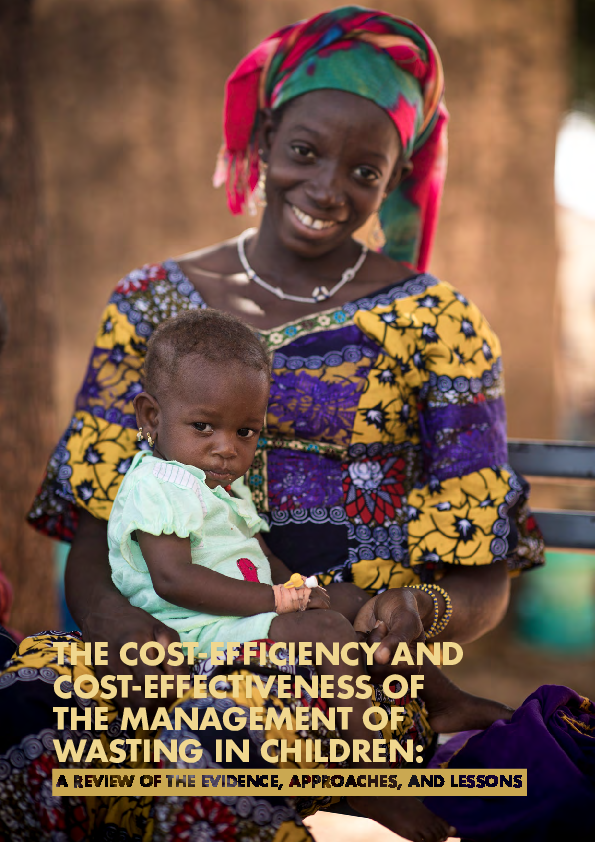
Study: Research
The Cost-efficiency and Cost-effectiveness of the Management of Wasting in Children: A review of the evidence, approaches, and lessons
Publication year:
2020
English
Format:
pdf (575.1 KiB)
Publisher:
AAH, Action Against Hunger,Save the Children UK
Wasting affects an estimated 49.5 million children worldwide, with 16.6 million suffering from the most life-threatening form, severe wasting. Yet, less than a third of children with severe wasting were able to access treatment in 2019. In March 2020 the World Health Organization released the Global Action Plan on Child Wasting, endorsed by UN agencies, which lays out an ambitious agenda to bring wasting treatment to scale, and identifies specific effective and cost-effective pathways to achieve this (WHO et al., 2020). Integration of wasting treatment into national primary healthcare services, treatment at the community level by community health workers as well as new ‘simplified approaches’ all have the potential to increase the coverage of services. However, within health system financing, budgets for community and primary care services are often stretched and policy-level decision-making needs to be informed by robust cost-effectiveness evidence. Evidence on cost-effectiveness is a critical gap in the journey to scaling up wasting treatment.
This review looks at the latest available studies which assess the cost-efficiency and cost-effectiveness of interventions to treat wasting. The objectives of this review were a) to assess the methodological approaches used in these analyses, and b) to capture the evidence on cost-efficiency and cost-effectiveness of wasting treatment.
The review included peer-reviewed papers and evaluation reports published online since 2000 as well as publicly available cost-efficiency and cost-effectiveness reports. 11 cost-effectiveness studies were found, including two looking at outpatient versus inpatient care, three looking at community health worker-led care, and one at the use of simplified combined protocols. The majority of these studies assessed programmes that were the short term and small-scale. Furthermore, 10 publications assessing cost-efficiency were identified assessing mostly standard community-based management of acute malnutrition (CMAM) programmes.
Indications are that CMAM is cost-effective. There is some evidence that community health worker-led treatment of severe wasting increases cost-effectiveness relative to outpatient treatment alone (Puett et al., 2013; Rogers et al., 2018), particularly in a high burden of malnutrition context (Puett et al., 2013). The combined protocol for the treatment of moderate and severe wasting was also found to be cost-effective compared to standard care (Bailey et al., 2020). Cost per child treated for severe wasting ranged from US$56 to US$805, while cost per child recovered ranged from US$114 to US$1041.
The high degree of variance in the findings suggests that important contextual determinants of cost-efficiency and cost-effectiveness are at play, including the scale of the programme, population density, the burden of wasting, and health system factors (IRC, 2016). It also reflects differences in the methods used in data collection and analysis. There were differences with respect to whose costs (only main implementor, all partners, beneficiary costs) and what costs (trainings, ready-to-use therapeutic foods (RUTFs), logistics, financial vs non-financial costs) were collected as well as in outputs and outcomes used to measure cost-efficiency and cost-effectiveness.
These findings point to the need for more cost-efficiency and cost-effectiveness analyses, in particular of largescale and longer-term community-based programmes and new approaches that are currently being implemented. Cost data collection, cost-efficiency, and cost-effectiveness analysis methodologies need to be agreed and standardized across the sector to allow comparison within and across contexts and to understand determinants of cost-efficiency, cost-effectiveness, and cost drivers.
Economic analyses can inform decision-making on treatment options and planning for implementation at scale in the contexts of different health systems, demographics, and burden of disease, and should therefore be more routinely integrated into programme implementation and monitoring. As highlighted in the Global Action Plan on Child Wasting, improving cost-effectiveness is also crucial for increasing treatment coverage and achieving a reduction in wasting prevalence to less 5% by 2025 (WHO et al., 2020).
Read full abstract
Authors
View & Download
Document information
Format
Content type
Topics
Rights
© Author/Publisher
Found a mistake? Help us improve!
If you have noticed a document assigned to the wrong author or any other inaccuracies, let us know! Your feedback helps us keep our data accurate and useful for everyone.
Share
Link
